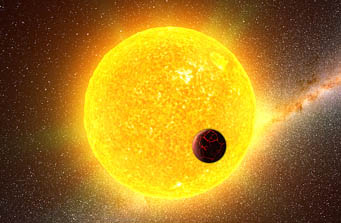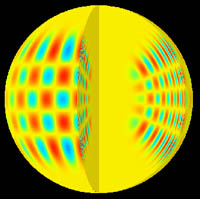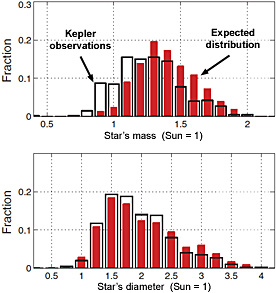You know how, in practically every war movie, the captured soldier only gives his name, rank, and serial number when being interrogated? For the longest time astronomers have had the same problem probing the basic characteristics of stars.
Temperature is the one easy quantity to measure; luminosity (total energy output) is a snap if you know the star's distance. But other essentials such as a star's diameter and mass are difficult to measure directly unless it happens to be in a binary system or (pure gold) an eclipsing binary system.

A star like our Sun is shown with an orbiting planet in the foreground. NASA's Kepler Mission is studying Sunlike stars by tracking changes in their brightness caused by internal oscillations.
Gabriel Perez Diaz / Instituto de Astrofisica de Canarias
Well, get ready for what some scientists are already hailing as a "golden age for stellar physics," thanks to observations being made by NASA's Kepler spacecraft.
Kepler, you'll recall, was launched two years ago to make wholesale discoveries of transiting extrasolar systems and, it's hoped, to identify worlds like Earth. It does so by staring at some 145,000 stars near the Cygnus-Lyra border. Those results have steadily poured in — just two months ago, mission scientists released a list of nearly 1,200 exoplanet candidates, many in multiple systems. Surely thousands more will be found.
That alone would be a boon to stellar studies, since those transiting planets make it easy to determine their host stars' masses and diameters. But now an international team of five dozen scientists has found a way to extract those values for stars without transiting planets. As the team writes in April 8th's Science, continually monitoring the light from all those stars has turned up many that periodically pulse in brightness due to acoustic waves coursing through their interiors.

A computer model of acoustic (p mode) waves resonating in the interior of the Sun.
Stanford
"Asteroseismology" isn't new. Physicists have known for decades that the Sun rings like a bell at frequencies with periods ranging from 1½ to 20 minutes. Each of these oscillation modes is sampling different parts of the solar interior.
A couple of dozen other stars were known to oscillate too, but Kepler's data has just blown the field of asteroseismology wide open. “These new observations allow us to measure the detailed properties of stars at an accuracy that wasn’t possible before,” notes Steve Kawaler, a coauthor of the paper from Iowa State University.
Led by William Chaplin (University of Birmingham), the team tracked more than 2,000 solar-type stars in Kepler's view for a month, using a special spacecraft mode that measured their brightness once per minute (versus the usual twice per hour). The observers found that about 500 of these stars exhibit oscillations, from which the stars' diameters and masses could be determined. The details get a little messy, but the Kepler data now provide a powerful new method for studying stellar interiors.

A census of 500 stars observed by Kepler reveals that while the distribution of stellar diameters runs close to theorists' predictions, their masses generally are less than expected.
W. Chaplin & others / Science
For example, Chaplin's team finds that Kepler's census of stellar diameters is a good fit to predictions, but that the studied stars generally have lower masses than expected. (The authors note that the masses could be skewed by unresolved binary systems.)
In any case, once these observations are melded with estimates of the stars' ages (now in the works), the full import of these new results will undoubtedly "shake up" astronomers' assumptions about how stars form and the range of sizes and masses they're born with.
 0
0
Comments
You must be logged in to post a comment.